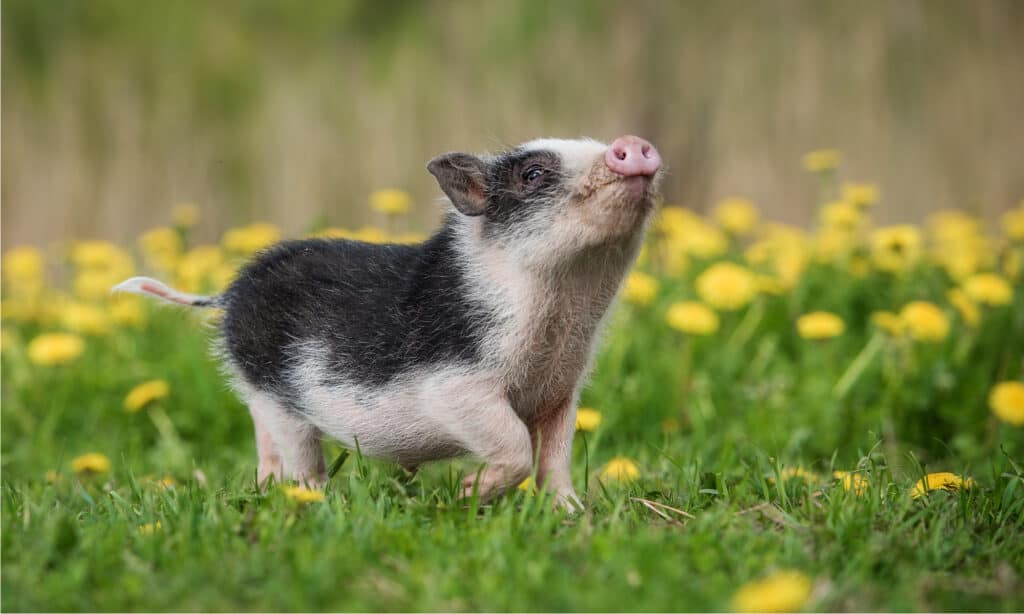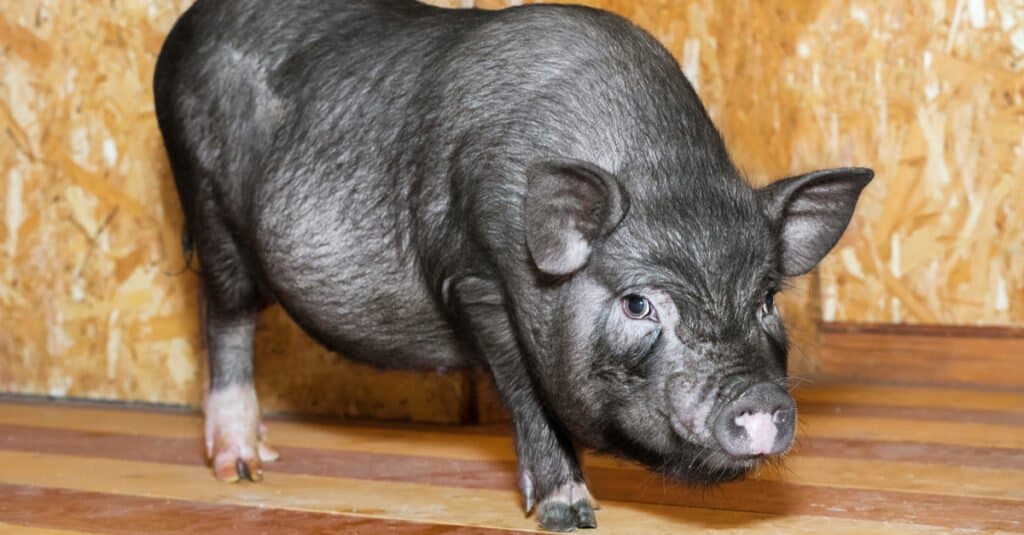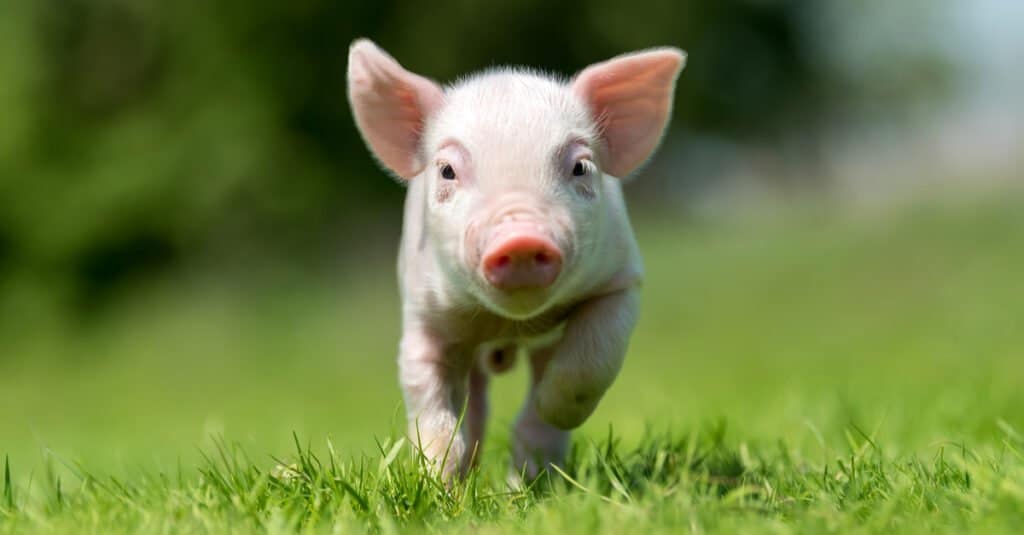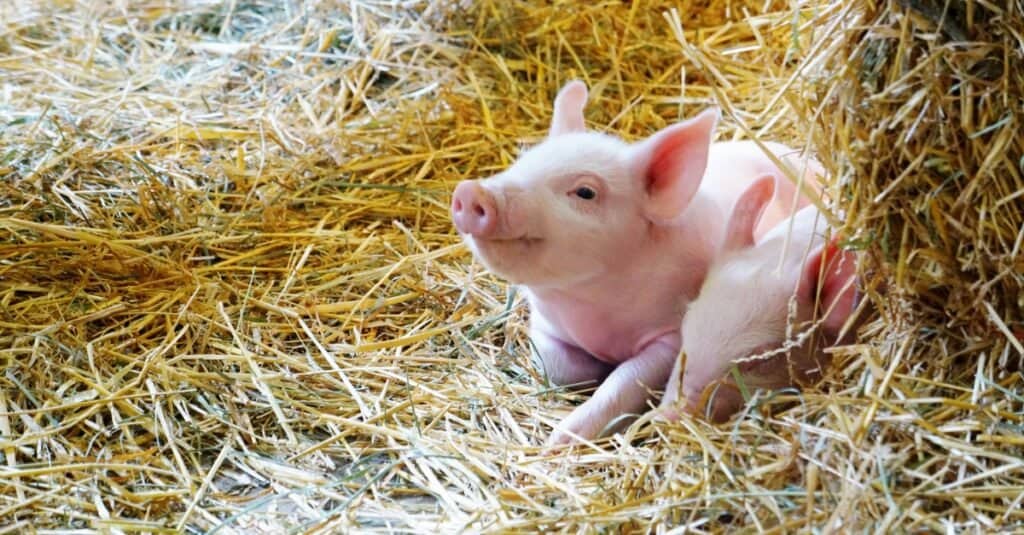Since prehistoric times, humans have been domesticating animals for consumption or companionship. Pigs were first domesticated in China around 8500 BC. The Entelodont, also known as terminator pigs or hell pigs, were enormous omnivores that inhabited the Earth from the Eocene to the Miocene epochs 37-16 million years ago. They scavenged meat and ate various meals, including small mammals and rough foliage, thanks to their massive teeth and powerful jaws. Domestic pigs come in various shapes and sizes, and there are hundreds of documented breeds. Sadly, breeds like the mule foot, Ossabaw Island hog, and Choctaw hog are highly endangered and on the verge of extinction. Let’s learn 10 incredible pig facts!
1. Pigs Do Not Sweat

Despite having sweat glands, pigs do not utilize their perspiration to cool themselves.
©Rita_Kochmarjova/Shutterstock.com
When analyzed, the statement “sweating like a pig” turns out to be nonsensical. This is because despite having sweat glands, pigs do not utilize their perspiration to cool themselves in the same manner that people do. Elephants and rhinoceroses are comparable in this sense. However, they do release body heat in a variety of ways, including panting.
2. Pig Squeals Can Be Incredibly Loud
Pigs communicate by oinking, grunting, and squealing, among other sounds that have been identified. Pig squeals can reach 115 decibels, which is almost as loud as a typical rock concert at 120 decibels. This is, without a doubt, one of the more fascinating pig facts.
Pigs create a wide variety of sounds. Squeals are typically utilized in unfavorable situations since they are loud, lengthy, and have a high frequency. Pigs also utter short, deep grunts that can be pleasant or negative.
3. Pig Snouts Are Really Advanced

Pigs have an excellent sense of smell.
©Anton Watman/Shutterstock.com
One of the most noticeable features of a pig’s look is its nose. They have a good sense of smell, thanks to their noses. It’s critical for seeking food and interacting with other pigs. They also use pheromones to warn other pigs of danger, as they can tell one another apart by smell.
4. Truffle Hunters Use Pigs to Find Truffles
Due to their sense of smell and penchant for rooting, pigs are sometimes used for hunting truffles. A hog can find truffles buried up to three feet. Supposedly, the aroma of truffles is like that of male pig sex hormones, hence pigs’ attraction to them.
The use of truffle pigs dates to the Roman Empire, during the Renaissance period. Dogs are now being used in truffle searches because they are less likely to eat the mushrooms they find.
5. Pigs Were Also Used in War
Not many people know about this particular pig fact. There are various instances of pigs being utilized in ancient conflicts. Because elephants were afraid of squealing pigs, war pigs are said to be amazingly effective against war elephants. Ancient Romans in 275 BC employed war pigs to intimidate Pyrrhus’ battle elephants.
To reduce their fear of pigs, several armies began to grow pigs and elephants together. However, at the siege of Megara in 266 BC, the Megarians herded pigs into the war elephants of the enemy army while dousing them in resin. Many soldiers in the army were crushed under the elephants’ fright and died.
6. Pigs Often Communicate Through Body Language

Though they are vocal, pigs also use their bodies to communicate.
©Volodymyr Burdiak/Shutterstock.com
Pigs may communicate with one another through body language in addition to sounds and smells. When they are enthusiastic, they can wag their tails like dogs. They can also use their snouts to poke you, smile at you, or cry at you. Piglets also tend to congregate in groups when they are cold.
Pigs use a variety of communication techniques and have complicated social structures. They use vocal communication, scent/pheromones, and body language to communicate with one another. We concentrate more on body language and speech cues because our sense of smell cannot detect most of their species-specific information.
7. Pigs Are Surprisingly Intelligent
Even among animals, pigs are one of the few that can look at a reflection and recognize their own likeness. They have a deep understanding of reflection mechanics and use that knowledge in their quest for sustenance. Even more intelligent than dogs, pigs can be taught to perform complex tasks like herding sheep and playing computer games! There are similarities in their intelligence to that of monkeys.
8. Pigs Have an Amazing Memory
Most pigs have a very vivid memory in addition to being intelligent. They are less likely than other animals to forget what they have learned. They can also recall experiences from their past, thanks to their episodic memory.
Pigs remember things quite well. They can recall where food is kept and locations where they have previously found food, according to studies. They are very adept at remembering directions and can navigate long distances to get home. Pigs can recognize and recall up to 30 other pigs as well as humans.
9. Momma Pigs Build Nests

Momma pigs build nests for the babies.
©iStock.com/NalinneJones
Before giving birth, sows or female pigs prepare their nests by excavating a tunnel and lining it with branches and leaves. The mother pig would pile the components together, forcing the softer components toward the center. They then begin to construct the nest, where they would lay down to give birth. Pigs give birth standing up, unlike other even-toed ungulates, such as cows and camels.
10. Mother Pigs Sing to Their Piglets When Feeding Them
This may the most unusual of our incredible pig facts. Piglets are fed by their mother every hour or so, and they will grunt at their mother to let her know they are hungry. Mother pigs have been seen to grunt at regular intervals when nursing their young, varying the volume and tone of their grunts in a manner reminiscent of singing. The piglets would recognize these sounds as signs that the mom is producing milk.
The photo featured at the top of this post is © iStock.com/kadmy
Thank you for reading! Have some feedback for us? Contact the AZ Animals editorial team.






